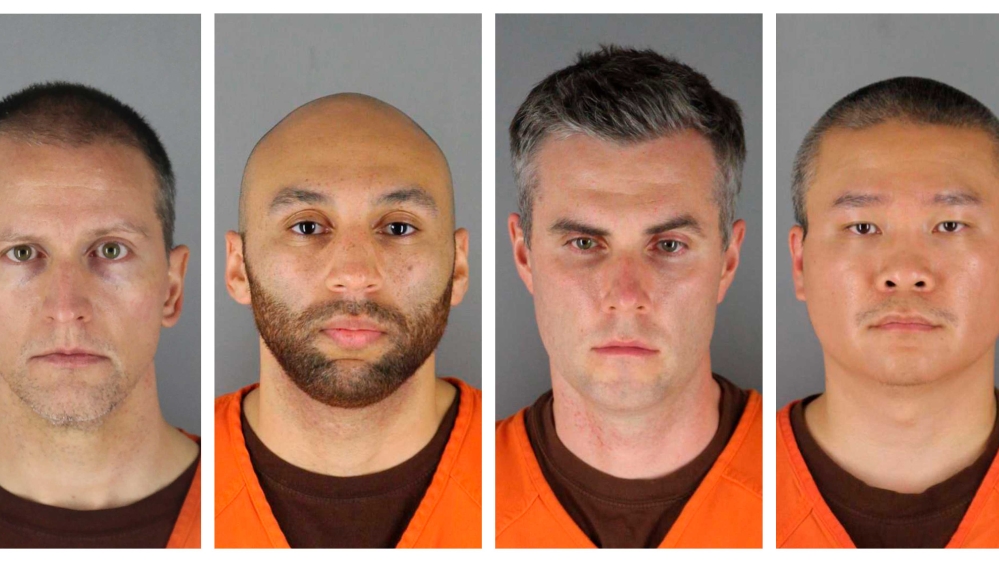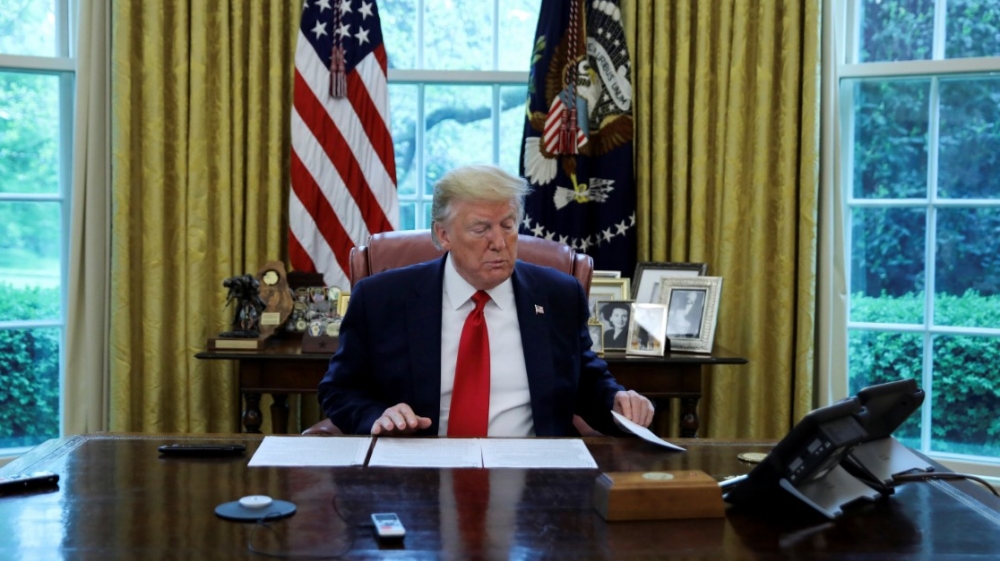Home » World News »
US AG Barr on racism, George Floyd, crime, Portland and Trump
Barr rejects Democrats’ assertions of racism in US policing and denies he favoured Trump’s friends in Mueller trials.
United States Attorney General William Barr appeared before the House Judiciary Committee on July 28 for the first time since taking office in February 2019.
Barr’s appearance came amid the deployment of federal law enforcement officers against crowds of protesters in Portland, Washington, DC, and other American cities.
Barr’s tenure as the top law enforcement official in the US has been controversial. Some Democratic politicians have called for Barr’s impeachment. More than a thousand former Justice Department lawyers have signed a letter urging him to step down. Four former presidents of the DC Bar Association have called for a professional ethics probe.
In the hearing, Democrats, who control a majority in the US House of Representatives, challenged Barr on a wide range of issues including whether he believes there is systemic racism in the US and whether he has favoured the president’s friends in prosecutions stemming from the Mueller probe.
Here are key excerpts of what Barr said during the five-hour hearing:
Police killings of Black men ‘quite rare’
“Police forces today are far more diverse than they’ve ever been. And there are both more Black police chiefs and more Black officers in the ranks. Although the death of George Floyd at the hands of the police was a shocking event, the fact is that these events are, fortunately, quite rare.”
Police killings not rooted in racism
“As one prominent Black professional in Washington said to me, African Americans will often feel treated as suspects first and citizens second, and I think these concerns are legitimate. At the same time, it would be an oversimplification to treat the problem is rooted in some deep-seated racism generally infecting our police departments. It seems far more likely that the problem stems from a complex mix of factors which can be addressed with focused attention over time.”
Police demonised in wake of George Floyd, most Black people killed by other Black people
“Unfortunately, some have chosen to respond to George Floyd’s death in a far less productive way by demonising the police, promoting slogans like ‘all cops are bastards’ and making grossly irresponsible programme proposals to defund the police. The demonisation of the police is not only unfair and inconsistent with principles of all people should be treated as individuals, but gravely injurious to the inner-city communities. When communities turn on and pillory the police, officers naturally become more risk-averse and crime rates soar. So, unfortunately, we are seeing that now in many of our cities, the threat to Black lives posed by crime on the streets is massively greater than any threat posed by police misconduct.”
Protests have been hijacked by rioters, notably in Portland
“In the wake of George Floyd’s death, violent rioters and anarchists have hijacked legitimate protests to wreak senseless havoc and destruction on innocent victims. The current situation in Portland is a telling example. Every night for the past two months, a mob of hundreds of rioters have laid siege to the federal courthouse and other nearby federal property. The rioters have come equipped for a fight, armed with powerful slingshots, tasers, sledgehammers, saws, knives, rifles and explosive devices. Inside the courthouse are a relatively small number of federal law enforcement personnel, charged with the defensive mission to protect the courthouse. What unfolds nightly around the courthouse cannot reasonably be called protest. It is, by any objective measure, an assault on the government of the United States.”
Rise in violent crime prompted federal deployments to US cities
“However, in the intervening time, we saw violent crime continuing to rise and a lot of that was triggered by the events after the death of George Floyd. So we did reboot the programme after COVID started breaking and we could commit the law enforcement resources to actually accomplish the mission, which is to reduce violent crime. Now, I regret that COVID interrupted our law enforcement activities, but it doesn’t obviate the fact that there is serious violent crime in these cities. These police departments and mayors have been asking us for help and we have put in additional federal agents and investigators to help deal with it.”
Did Barr talk politics with Trump in context of federal police response?
“I’m a member of the cabinet. And there’s an election going on, obviously, the topic comes up in cabinet meetings and other things. It shouldn’t be a surprise that topic of the election was discussed.
“I’m not going to get into my discussions with the president, but I’ve made it clear that I would like to pick the cities based on law enforcement need and based on neutral criteria.”
Roger Stone’s prosecution excessive
“Stone was prosecuted under me. And I said all along, I thought that was a righteous prosecution. I thought he should go to jail. And I thought the judge’s sentence was correct. But the line prosecutors were trying to advocate for a sentence that was more than twice anyone else in a similar position had ever served and this is a 67-year-old man, first time offender, no violence, and they were trying to put him in jail for seven to nine years. And I wasn’t going to advocate that, because that is not the rule of law. I agree the president’s friends don’t deserve special breaks but they also don’t deserve to be treated more harshly than other people.”
Michael Flynn investigation unwarranted
“Well, I would just say I asked another US Attorney in St Louis, who had 10 years in the FBI and 10 years in the Department of Justice as a career prosecutor, to take a look at it. And he determined based on documents that had not been provided to the Flynn side and not been provided to the court, that in fact, there was no basis to investigate Flynn. And furthermore, it was clearly established by the documents that the FBI agents who interviewed him did not believe that they thought he was lying.”
“What the counsel concluded was that the only purpose of the interview – the only purpose – was to try to catch him in saying something that they could then say was a lie. So then, therefore, the interview was untethered to any legitimate investigation.”
Barr’s role in Lafayette Square on June 1
“There was unprecedented rioting right around the White House, very violent. During that time … we had around 90 officers injured. I’m talking about things like concussions, one was operated on and so forth … It was so bad that – as it’s been reported – the Secret Service recommended the president go down to the shelter. We had a breach of the Treasury Department. The historical building on Lafayette Park was burned down. St John’s was set on fire. Bricks were thrown at the police repeatedly. They took crowbars and pried up the pavers at Lafayette Park and threw those at the police. Balloons of caustic liquids were thrown on the police. And it was clear when I arrived at the White House on Monday, there was total consensus that we couldn’t allow that to happen so close to the White House, that kind of rioting. And therefore we had to move the perimeter out one block and push it up toward I Street. And there was already a plan in being at that point that the Park Police and the Secret Service had worked out the night before, which was to put the perimeter further away and then give them time to put a non-scaleable fence across the northern part of the park.”
Tactical decisions were made by US Park Police
“During the day, the factors that led to the timing of it was that movement was going to be made as soon as there were enough units in place to actually perform it and units were very slow in getting into place throughout the day, much to my frustration, because I wanted to move before there was a big buildup of demonstrators, and also the fencing had to be delivered. And when those things were accomplished the tactical commander in charge of the Park Police proceeded with the movement of pushing the perimeter. So this was something conceived long before and didn’t turn on the nature of the crowd, although I would say the crowd was very unruly. And while the tactical considerations were made by the Park Police, they tried to respond to the situation.”
On Trump’s photo in front of St John’s church
“To say that this had to do with the photo op, I don’t mean to analogise this to a military operation, but it’s akin to saying that we invaded the Philippines in World War II so Douglas MacArthur could walk through the surf on the beach, one follows the other but we did not invade the Philippines so that MacArthur could walk to the beach.”
Source: Read Full Article








